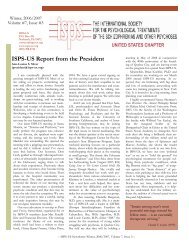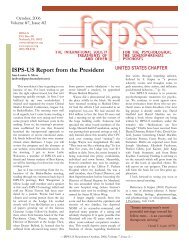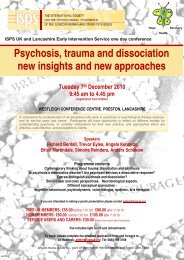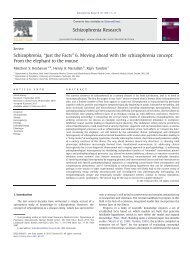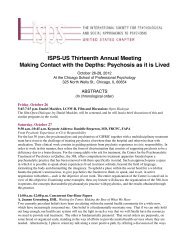Spring 2011 - ISPS-US
Spring 2011 - ISPS-US
Spring 2011 - ISPS-US
You also want an ePaper? Increase the reach of your titles
YUMPU automatically turns print PDFs into web optimized ePapers that Google loves.
10<br />
Continued from page 11<br />
This presentation highlights the wide range of positive and negative elements that impact in-depth psychotherapy and how they came<br />
together in a successful psychotherapy case. Attendees will learn what kind of psychotherapeutic work is possible a non-traditional setting<br />
like a prison, and that seemingly negative factors can be an opportunity for the work to deepen if both therapist and inmate are aware<br />
of the fertile environment they share.<br />
Martha Rose, MBA:<br />
The Social Construct of Schizophrenia: Deinstitutionalization to Criminalization of the Mentally Ill<br />
This paper examines how the definition and social construct of mental illness has seen a dramatic shift. Politics, finance, economics,<br />
and distortions in public perception have driven policy considerations. These policy decisions have dramatically changed the treatment<br />
available, and the overall societal attitudes.<br />
In the 1950s new medications altered the external behavior of people who previously had been seen as bizarre and dangerous. These<br />
drugs demonstrated that what had at the time been considered a psychological problem was in fact a physiological problem.<br />
Now, most mental illnesses are treated as brain disease, and managed from a bio-neurological perspective. The thinking is that people<br />
need to use medications to control their minds and actions Current research and social conditions indicate that this medicalized approach<br />
to treatment is insufficient at best, and harmful at worst. There are concerns being raised on the iatrogenic effect of the medications,<br />
contributing to the increased level and intensity of emotional disturbance within society.<br />
This change in social construct emptied the mental hospitals, while shifting much of the financial burden from state budgets to Federal<br />
entitlement programs. It also led to a void in services to address the social, emotional, and psychological aspects of treatment.<br />
An unintended result has been incarceration for many. The nation’s jails and prisons now house disproportionate numbers of the<br />
mentally ill. Close to 60% of the prison population is considered to have a mental illness, with the seriously mentally ill representing half<br />
of that group, or 25% of the entire correction population.<br />
Ira Steinman, MD:<br />
Released in Shackles AMA from the Hospital for the Criminally Insane<br />
An over-riding principle of the presenter’s psychotherapeutic approach is that Intensive Psychotherapy of Psychosis, emphasizing<br />
unconscious motivation, transference, counter-transference, resistance, and interpretations of these factors, is very useful, sometimes<br />
curative, in an out patient practice. But what of the usefulness of such an inquiring psychotherapeutic approach with an in-patient?<br />
Jill appeared on the presenter’s doorstep, replete with family and a guard, having been released to his office against medical advice<br />
from a hospital for the criminally insane on court order. It was the first he had heard about her.<br />
She had been in the hospital for three years, loaded up on tremendous amounts of antipsychotic and mood stabilizing medications, in<br />
an attempt to keep her from attacking staff members during paranoid and hallucinating rages. He debated whether or not to see such a<br />
patient out of the hospital, but did so when the family made the compelling argument that things hadn't gotten better in three years in the<br />
hospital. They asked if he could talk with her in his office. He did.<br />
They quickly uncovered the transference source of the paranoia, hallucinations, rages and attacks upon staff members, leading to a<br />
marked improvement in her condition, vastly less antipsychotic medication, and a return to living in her community out of the hospital.<br />
Yet again, Intensive Psychotherapy of Psychosis prevailed, where three years of previous hospitalization and huge amounts of antipsychotic<br />
and mood stabilizing medication left the patient in a confused and incarcerated morass.<br />
A Traumatic Cause, Without Which Schizophrenia is Unlikely to Occur (conversation hour).<br />
Clancy D. McKenzie, MD<br />
Conversation hour or round table discussion reference anything in book: “Babies Need Mothers” – How Mothers Can Prevent Mental Illness<br />
in their Children<br />
This is an opportunity for participants to delve into the realities of the infant and see what is real to the infant at each month of its<br />
development. The infant cannot verbalize this, but the reality is re-experienced in the adult psychotic who can, and thus it can be examined<br />
and deciphered. Through identification of age of origin, by correlating symptoms with precise age of infant when traumatized, it is<br />
possible to identify five parameters: age-of-origin specific reality, feelings, behavior, body movements and level of affective expression.<br />
The discussion can include any aspect of treatment – as well as prevention at three levels: 1. Prevention or attenuation of original<br />
trauma, 2. Prevention or attenuation of second trauma, which prevents the disorder from ever occurring, and 3. Prevention of recurrence<br />
based on new understanding.<br />
Simple enlightenment techniques are discussed in later chapters, including programmed dreams. You need not be a yogi and meditate<br />
50 years in a cave to achieve enlightened answers. During sleep you reach just as deep a level of consciousness. You merely take one minute<br />
to formulate the question and one minute to receive the answer upon awakening.<br />
Volumes are written about the first dream brought into psychoanalysis, because often it reveals the primary unconscious dynamics<br />
and what caused them. Prior to starting, the patient might have his most intense wish to know what the unconscious problems are and<br />
what caused them. Often the first dream provides the answer.<br />
—<strong>ISPS</strong>-<strong>US</strong> Newsletter: <strong>Spring</strong>, <strong>2011</strong>, Volume 11, Issue 4—<br />
Continued on page 11



